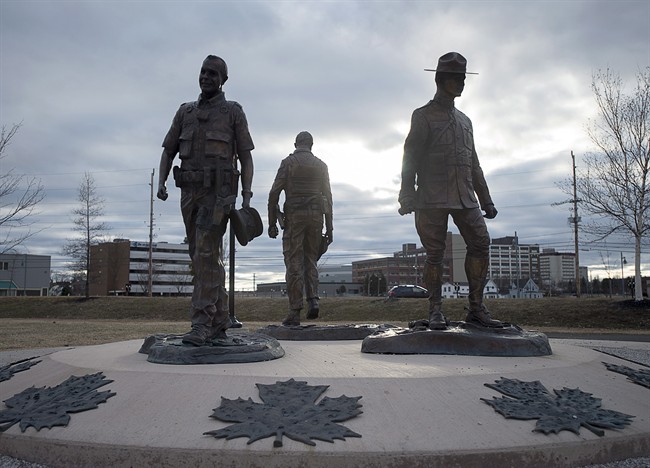MONCTON, N.B. – A senior RCMP officer says he warned superiors about the lack of firepower for front line officers long before the 2014 Moncton shooting rampage that left three Mounties dead.

Supt. Troy Lightfoot told the RCMP’s trial on labour code charges Thursday he became concerned about officer and public safety after various active shooter incidents including the 2005 attack in Mayerthorpe, Alta., that killed four Mounties.
“We felt at the time that we were basically outgunned,” Lightfoot said of active shooter incidents. “I felt that we needed new tools.”
READ MORE: Funding played role in deployment of rifle: Witness at RCMP labour trial
The allegations against the RCMP stem from its response to Justin Bourque‘s shooting rampage in Moncton, N.B., in which he killed three officers and wounded two others. Bourque was armed with a semi-automatic rifle.
Police use of C8 carbine rifles became a central focus in the fallout from the shootings, with some Moncton officers complaining they were outgunned because they did not have carbines. The high-powered weapons have a greater range than the officers’ standard-issue pistols.
Lightfoot told Moncton provincial court Judge Leslie Jackson he contributed to a briefing note in 2006 that recommended looking at carbines for Mounties, and was told his team should continue researching the issue.
WATCH: ‘Pronounced failure’ by RCMP in 2014 Moncton shooting?

But Lightfoot said the RCMP then became focused on the public backlash stemming from the 2007 Tasering death of Robert Dziekanski in Vancouver, and he expressed concerns about the lack of resources being put towards progressing the carbine file.
“It was unattainable to address it alone, or without other resources,” said Lightfoot, an expert in tactical operations and use of force.
Lightfoot – who in 2006 was in charge of the RCMP’s operational policy section – said an independent researcher was eventually hired in 2009 to look at carbines for the force.
READ MORE: N.B. trial continues for RCMP over response to Justin Bourque’s shooting rampage
Lightfoot said the researcher’s report the following year recommended the RCMP pursue a carbine program, but it was rejected by senior management. He testified that he did not know why.
The national police force ultimately approved the C8 carbine rifles in September 2011, but the rollout took time.
Earlier this week, Supt. Bruce Stuart testified that the carbine purchasing, training and rollout was a highly complicated process with many people involved, and one that was not to be rushed.
Stuart, a use of force expert who worked with Lightfoot, agreed when asked by defence attorney Ian Carter on Wednesday if he had attempted to ensure carbines were adopted in timely way, while also making sure the process was done appropriately.
READ MORE: Some Mountie deaths in 2014 Moncton massacre may have been preventable: Crown
Crown prosecutor Paul Adams has said the majority of the Moncton officers who responded to the active-shooter call on June 4, 2014, lacked full training.
In his opening comments, he said some of the fatalities could have been avoided had the force complied with labour laws.
Alphonse MacNeil, a retired assistant commissioner with the RCMP, has said the carbines should be rolled out faster. His 2015 report on the Moncton shootings concluded the high-powered weapons could have made a difference in that incident.



Comments